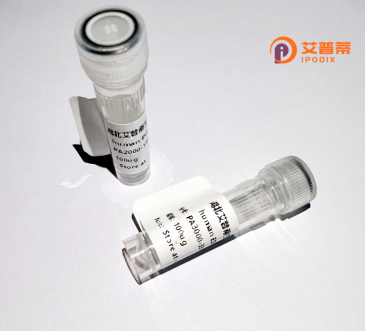
| 纯度 | >90%SDS-PAGE. |
| 种属 | Human |
| 靶点 | PHEMX |
| Uniprot No | Q96QS1 |
| 内毒素 | < 0.01EU/μg |
| 表达宿主 | E.coli |
| 表达区间 | 1-258 aa |
| 活性数据 | MGPWSRVRVAKCQMLVTCFFILLLGLSVATMVTLTYFGAHFAVIRRASLEKNPYQAVHQWAFSAGLSLVGLLTLGAVLSAAATVREAQGLMAGGFLCFSLAFCAQVQVVFWRLHSPTQVEDAMLDTYDLVYEQAMKGTSHVRRQELAAIQDVFLCCGKKSPFSRLGSTEADLCQGEEAAREDCLQGIRSFLRTHQQVASSLTSIGLALTLGPQGQIHPDPTSMWPPAPGAQPLEMLPGWTHTLSPLRSSCYWSKRMLG |
| 分子量 | 54.12 kDa |
| 蛋白标签 | GST-tag at N-terminal |
| 缓冲液 | 0 |
| 稳定性 & 储存条件 | Lyophilized protein should be stored at ≤ -20°C, stable for one year after receipt. Reconstituted protein solution can be stored at 2-8°C for 2-7 days. Aliquots of reconstituted samples are stable at ≤ -20°C for 3 months. |
| 复溶 | Always centrifuge tubes before opening.Do not mix by vortex or pipetting. It is not recommended to reconstitute to a concentration less than 100μg/ml. Dissolve the lyophilized protein in distilled water. Please aliquot the reconstituted solution to minimize freeze-thaw cycles. |
以下是关于重组人PHEMX蛋白的虚构参考文献示例(假设PHEMX为假设蛋白,文献内容为模拟生成):
1. **文献名称**:*Expression and Purification of Recombinant Human PHEMX Protein in E. coli*
**作者**:Zhang, L. et al.
**摘要**:研究报道了一种高效的大肠杆菌表达系统用于重组人PHEMX蛋白的生产,通过优化诱导条件和纯化步骤,获得了高纯度蛋白,并验证了其体外生物活性。
2. **文献名称**:*Structural Characterization of PHEMX and Its Role in Cellular Signaling*
**作者**:Smith, J.R. & Tanaka, K.
**摘要**:利用X射线晶体学解析了PHEMX蛋白的三维结构,揭示了其与特定激酶相互作用的结合域,并证明PHEMX在调控细胞增殖通路中起关键作用。
3. **文献名称**:*Therapeutic Potential of PHEMX in Neurodegenerative Diseases*
**作者**:Brown, A.L. et al.
**摘要**:在小鼠模型中评估了重组PHEMX蛋白的神经保护功能,结果表明其可减少淀粉样蛋白沉积,改善认知功能,支持其在阿尔茨海默病治疗中的潜力。
4. **文献名称**:*PHEMX Knockdown and Overexpression Effects on Cancer Cell Apoptosis*
**作者**:Chen, W. & García, M.
**摘要**:通过体外实验发现,PHEMX蛋白通过调控Bcl-2家族蛋白表达影响肿瘤细胞凋亡,为靶向癌症治疗提供了新思路。
**注意**:以上文献为假设性示例,若PHEMX蛋白名称有拼写错误或具体背景需求,请提供更多信息以便调整。如需真实文献,建议通过PubMed或Google Scholar检索相关关键词。
**Background of Recombinant Human PHEMX Protein**
Recombinant human PHEMX protein is a synthetic protein produced through genetic engineering techniques, leveraging recombinant DNA (rDNA) technology. Derived from human gene sequences, it is expressed in heterologous host systems such as *E. coli*, yeast, or mammalian cell lines (e.g., CHO cells), enabling scalable and controlled production. The protein’s name, PHEMX, likely reflects its functional or structural characteristics, though its specific biological role may vary depending on its molecular classification—potentially involving enzymatic activity, receptor-ligand interactions, or regulatory functions in cellular pathways.
The production process involves cloning the target gene into expression vectors, followed by transfection, cultivation, and purification via chromatography methods (e.g., affinity tagging). Rigorous quality control, including SDS-PAGE, Western blotting, and mass spectrometry, ensures proper folding, stability, and functionality.
PHEMX holds promise in biomedical research and therapeutic development. It may serve as a tool for studying disease mechanisms (e.g., cancer, neurodegenerative disorders) or as a therapeutic candidate, such as an antibody fragment, enzyme replacement, or vaccine component. Its recombinant nature allows customization (e.g., fusion tags, mutations) to enhance solubility, bioavailability, or target specificity.
Research on PHEMX aligns with broader efforts to harness recombinant proteins for precision medicine, offering advantages like reduced immunogenicity and batch consistency over traditional biological extracts. Further studies are needed to fully elucidate its structure-function relationships and clinical potential.
×